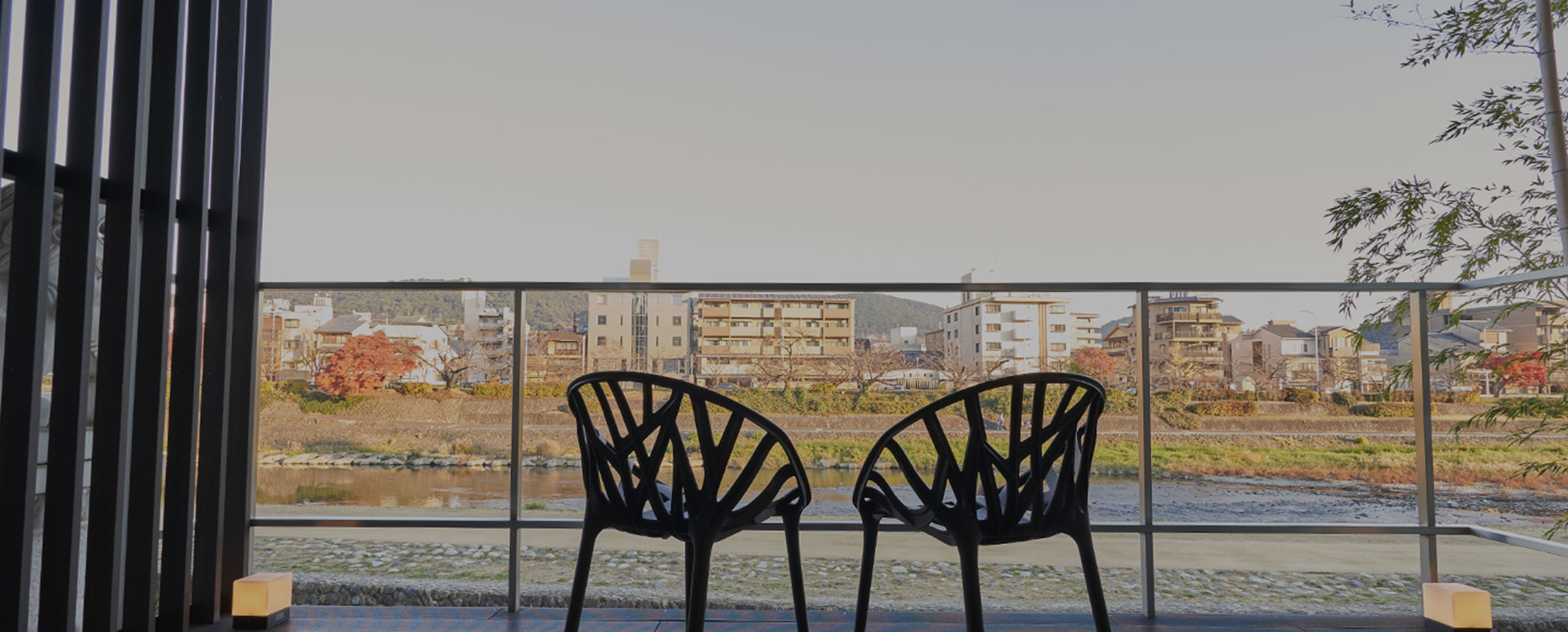SIGHTSEEING
The unique world view of Kyoto.
Views of temples and shrines that change with the seasons.
AOI Suites at Nanzenji and AOI Hotel Kyoto are located in the middle of the city, where visitors can enjoy the true essence of Kyoto, as it is filled with rows of long-established Japanese inns and restaurants, and is near famous temples in Higashiyama.
There are many historic Kyoto spots in the vicinity, so we invite you to visit them and experience the nostalgic atmosphere created by the historic and traditional buildings.
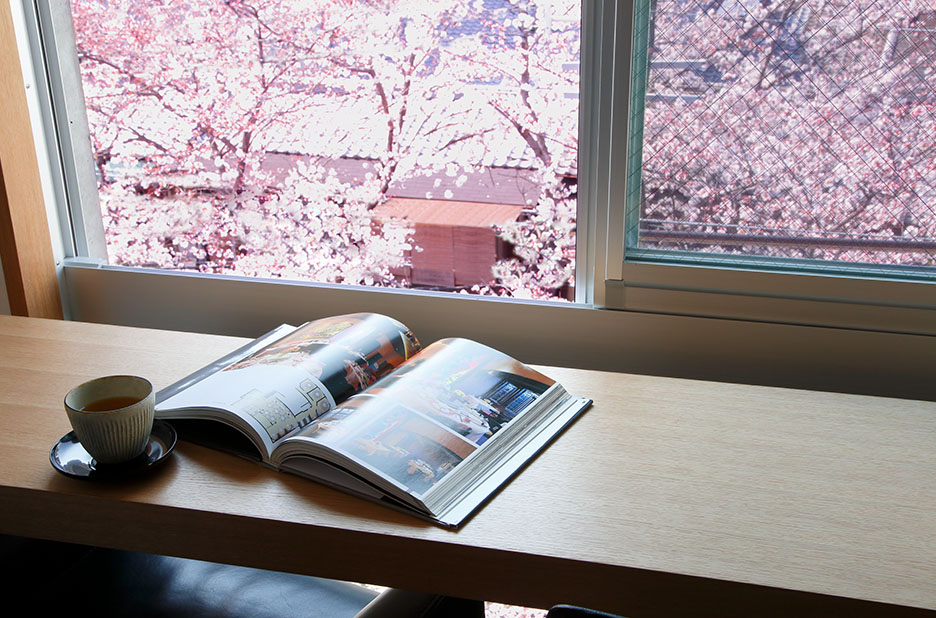

GINKAKUJI TEMPLE AREA

GINKAKUJI TEMPLE
Officially known as Higashiyama Jishoji temple, Ginkakuji temple is one of the sub-temples of Shokoku-ji temple. It is said to have been named Ginkakuji after Kinkaku-ji temple in the Edo period. Highly acclaimed for its historical value, it became a World Heritage Site as a Historic Monument of Ancient Kyoto in 1994.
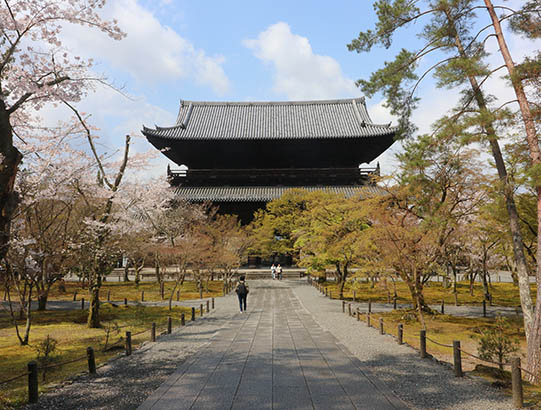
NANZENJI TEMPLE
The first Zen temple in Japan to be built under the order of the emperor, Nanzenji is a temple given special treatment that is positioned above Kyoto Gozan (five most important Zen temples of Kyoto) and Kamakura Gozan (five most important Zen temples of Kamakura). With cherry blossoms in spring, the fresh green leaves of maple trees in early summer, and autumn leaves in autumn, as well as the refreshing sound of water from Lake Biwa Canal flowing through the temple precincts, this temple has also become famous as a "cool spot" in summer in Kyoto.

KENNINJI TEMPLE
Kenninji temple is the oldest Zen temple in Kyoto that conveys the teachings of Zen. Founded by Eisai, a Buddhist monk who trained in China, this temple is still popular with tourists today, more than 800 years after its construction.

EIKANDO TEMPLE
Eikando temple is known as the best spot for viewing autumn leaves in Kyoto. In autumn, about 3,000 Japanese maple and Japanese omomiji maple trees add vivid colors to the gardens surrounding Hojo-ike pond.

HEIAN SHRINE
Heian Shrine was founded to commemorate the 1,100th anniversary of the transfer of the national capital to Kyoto. It is also known as a famous spot for viewing cherry blossoms that is loved by numerous writers, including Junichiro Tanizaki, who is known for his literary works such as "Sasameyuki."
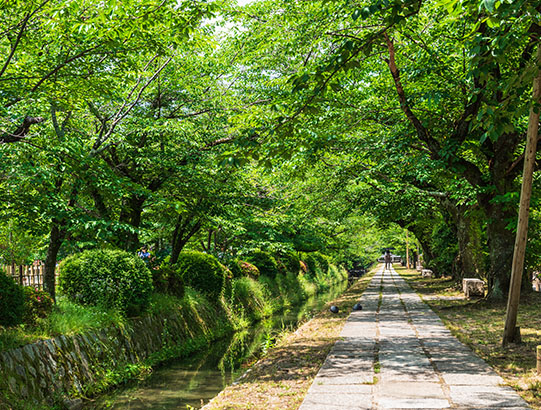
PHILOSOPHER'S PATH
Spanning about 2km, the Philosopher's Path is a walkway between Ginkakuji temple and Nanzenji temple. It was initially considered a road as it was covered with grass, but the number of people walking through this road increased and numerous literary artists came to live there during the Meiji period, so it was called the "Literati's Path."
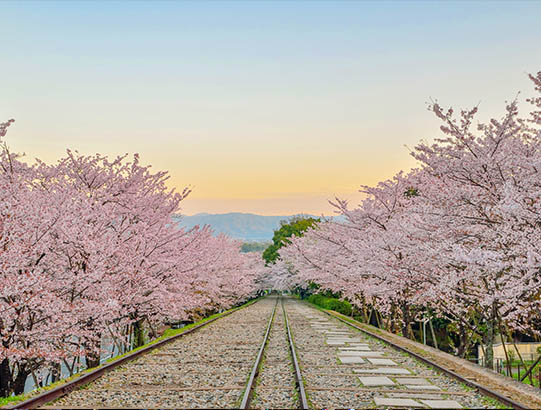
KEAGE INCLINE
Located near Nanzenji temple, the Keage Incline was the world's longest sloping railway track with a total length of 582m. It was built in 1891 to move boats on the steep incline of Lake Biwa Canal that had a height difference of about 36m. The railway was abolished in 1948, and the area is now designated as a cultural property of Kyoto City.
SHOP LIST
OMEN GINKAJUJI HONTEN
This restaurant takes pride in its homemade noodles, which are handmade using domestic wheat. Artisans who know all the characteristics of wheat are the ones who make the noodles carefully. Enjoy delicious udon with authentic dashi made from handpicked kelp and bonito. You will taste the delicious flavors of wheat.

KIYOMIZU AREA
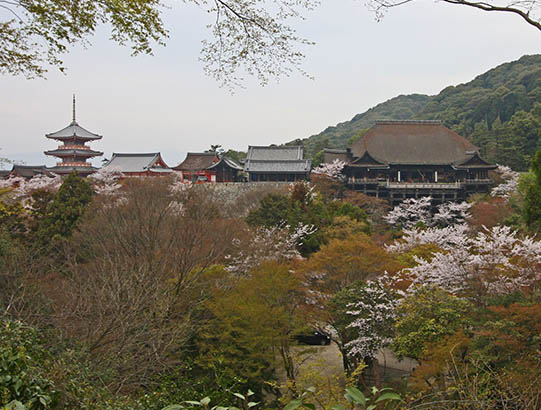
KIYOMIZU TEMPLE
It is a historic temple with a history spanning about 1,200 years, recognized as a World Heritage Site. Inside its precincts, you will find the main hall, where the saying "jump off the stage of Kiyomizu (which means to make a leap into the dark)" originated, as well as national treasures and important cultural properties such as the three-storied pagoda. You can also see power spots such as the Otowa Waterfall, which is believed to help worshipers find success in love, and Zuigudo Hall, which is famous for its tour that will make you feel like you are inside a mother's womb.
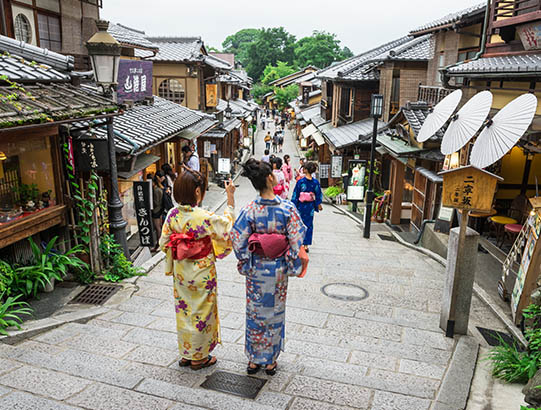
NINENZAKA
Ninenzaka is a stone-paved road that comes after you turn right from Ichinenzaka to go to Sannenzaka. It was built during the Taisho era, but in recent years, the electric wires have been buried underground. A charming road that has kept the atmosphere of the Taisho era intact, this road is also a popular spot for taking photos. It is also known to be a place near the residence of painter and poet Yumeji Takehisa.

SANJUSANGENDO
Sanjusangendo is officially known as Rengeoin temple. It is a temple that enshrines Rengeo (the Lotus King), or the thousand-armed Kannon, as its principal object of worship. A Buddhist temple outside the precincts of the Tendai sect's Myoho-in temple, it houses 1,001 thousand-armed Kannon, and this powerful sight has proven to be irresistible to visitors.

KODAIJI TEMPLE
The vast garden that is set against the backdrop of Higashiyama mountain in Kodaiji temple adopts a Rokaku Sansui design wherein two ponds and two corridors spread out around the Kaisando Hall. This temple is a famous spot for viewing autumn leaves. It is known as a garden representing the Momoyama period, with a moon viewing pavilion loved by Hideyoshi Toyotomi built over Engetsu-ike pond, Kamejima island to the north, and Tsurujima island at the peninsula to the south.

EITOKUIN TEMPLE
Representing one of the sub-temples of Kodaiji temple, Entokuin temple began with the relocation of the Kesho Goten Palace (dressing palace) and garden from Fushimi-jo Castle in 1605, the year before the construction of Kodaiji temple, and the construction of a new guest hall. It is said that Nene, the legal wife of Hideyoshi Toyotomi, spent her last 19 years here and visited Kodaiji temple in the vicinity to pray for the soul of Hideyoshi.
SHOP LIST
AKOYA CHAYA
Akoya Chaya is a restaurant offering all-you-can-eat buffet of ochazuke (cooked rice with tea poured on it) where you can try a variety of pickled vegetables. Enjoy the satisfaction of having a full stomach in a healthy way by combining 20 kinds of pickled vegetables, such as eggplant, cucumber, and Chinese yam, with white rice, 16-grain mixed rice, and porridge. After the meal, you can relax with Japanese tea and wafer cake filled with bean jam (coarse sweet red bean paste and bean jam with green tea).
JUMONDO
Jumondo offers five types of Suzunari dango (dumplings): Kyoto-style white miso, sweet soy glaze with roasted soybean flour, black sesame soy sauce, grilled with soy sauce and nori, and coarse sweet red bean paste. Other popular menu items are the Suzunari wafer cake filled with hojicha cream with a truly mysterious flavor, matcha jelly, red bean soup made with azuki beans, and mashed sweet potatoes with sweetened chestnuts. This restaurant also offers drinks unique to Kyoto, including matcha, matcha latte and green tea.

GION AREA

YASAKA SHRINE
An old shrine that has been located at its site since before the relocation of the capital to Kyoto (794), Yasaka Shrine is more commonly known as "Gion-san." Its main enshrined deity, Susanoo no Mikoto, is worshipped as a god who wards off all kinds of misfortune. Many deities are enshrined in the temple precincts. This is the grand head shrine of the Yasaka shrines, which are shrines dedicated to the Gion faith that number approximately 2,300 shrines throughout Japan.

CHION-IN TEMPLE
Located at the foot of Mt. Kacho, one of the thirty-six mountains of Higashiyama in Kyoto, Chion-in temple is the head temple of the Jodo Sect that is filled with large and small temple buildings. It has been welcoming visitors with its majestic appearance that exudes a solemn yet easy-going atmosphere, which is perfect for the birthplace of the teachings of the Buddha.

SHOREN-IN TEMPLE
Shoren-in temple, also known as "Awata Gosho (Awata Palace)," is one of the three Monzeki Temples of the Tendai Sect. What began as a lodging facility for priests built at the top of Mt. Hiei, it is said to be one of the residences of the high priests during that time, together with Saicho and En-nin. It houses the Garden of Kirishima, which is said to have been created by Enshu Kobori, where you can feel the beauty of each season in Kyoto.
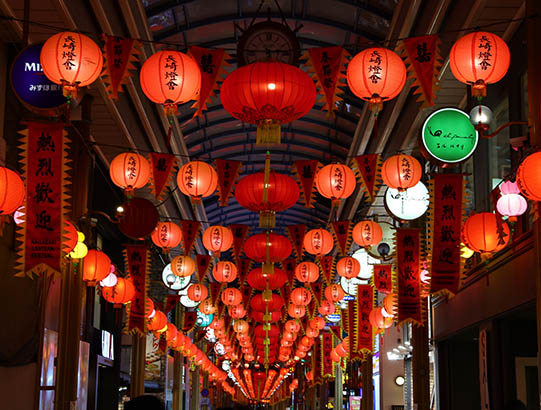
NISHIKI MARKET
Walking through this 390-meter long market is also a walk along a long history of 400 years. Nishiki Market is not all about its long history and arcade, as it is also a very deep and extensive shopping district. Enjoy rare ingredients that you cannot find anywhere else, the unique food culture of Kyoto, and various kinds of brocade.
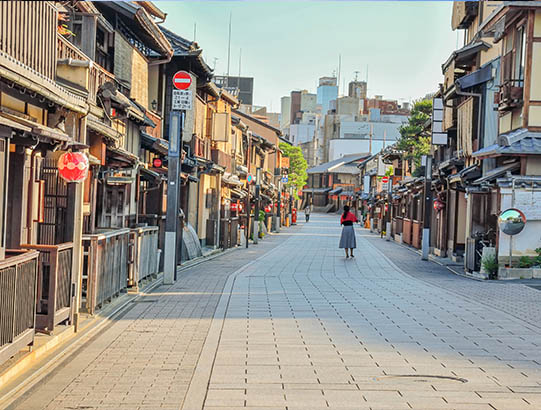
HANAMIKOJI STREET
Hanamikoji Street is lined with teahouses enveloped in the true Gion atmosphere created by the inuyarai (bamboo fences) and red lattice houses, with the nostalgic vibe of the area giving a calming effect to visitors. Ichiriki is the teahouse that best symbolizes Hanamikoji Street. The stretch from here to Kenninji temple is truly the most beautiful you have ever seen, as the stone pavement enhances the surrounding buildings.

HONNOJI TEMPLE
The famous "Honnoji Incident" in history that is said to have taken place at Honnoji temple actually happened at the place near Takoyakushi Nishinotoin rather than where the current Honnoji temple is located. As a vestige of such event, a stone monument of the former site of Honnoji temple is built at the southwest corner of the Takoyakushi-Ogawa intersection.

MARUYAMA PARK
Maruyama Park, opened in 1886, is the oldest park in Kyoto City. Famous as a spot for viewing cherry blossoms, especially the Gion weeping cherry trees, it has been developed as one of the most enjoyable recreation areas in the city since ancient times. It was also designated as a national place of scenic beauty in 1931.
SHOP LIST
IZUJU
At Izuju, most of the ingredients are sourced from the production areas and central market, including every fish in season. Enjoy traditional flavors made with a cooking method that has remained unchanged for 100 years.
GION KOMORI
Gion Komori is a popular sweets shop on Shimbashi-dori in Gion, where an atmosphere unique to Kyoto drifts in the air. Enjoy fine sweets made with handpicked ingredients, such as matcha parfait made with Uji matcha green tea and red bean soup made with Dainagon azuki beans from Tokachi, in this shop that used to be a teahouse adjacent to Shirakawa river. Here, you can almost hear the murmuring of the river.

FUSHIMI / KYOTO STATION AREA

FUSHIMI INARI SHRINE
Fushimi Inari shrine, which has been capturing the attention of visitors from overseas, is also known as "Oinari-san." As the head shrine of all Inari shrines that are said to number approximately 30,000 shrines throughout Japan, it is a shrine that is popular with all Japanese men and women of all ages. In addition, the beautiful, bright vermillion-colored "Senbon Torii (a thousand torii gates)" create a magical and elegant sight.

TOFUKUJI TEMPLE
Tofukuji temple is the fourth Zen temple of Kyoto Gozan (five most important Zen temples of Kyoto) that paints Kyoto in autumn leaves during autumn. You can enjoy the picturesque scenery created by historic architectural structures and the magnificent beauty of nature.

NISHI HONGANJI TEMPLE
This is the head temple of the Jodo Shinshu Honganji Sect of Buddhism that was founded by Shinran Shonin in the middle of the Kamakura period. The Karamon gate, a national treasure of Japan, is a representative structure of the Momoyama culture as it also conveys the remains of Fushimi Castle. It is also called "Higurashi-mon (Twilight Gate)" because it is so beautiful that you will not be able to stop looking at it until the sun goes down.

SHINSHU HONBYO (HIGASHI HONGANJI TEMPLE)
This historic temple in Kyoto is the head temple of the Otani School of the Jodo Shinshu Sect and enshrines the imperial portrait of Shinran Shonin, the founder of the sect. It has two wooden temple gates that are the largest in the world. If you walk through Goeido Gate, which is said to be the largest structure of its kind in Japan, you will see Goeido Hall and Amidado Hall.

SENNYUJI TEMPLE
Located near Kyoto Station, this is the head temple of the Sennyuji School of the Shingon Sect that is closely related to the Imperial Family. Japan's largest painting of "Buddha's Nirvana," the painting of the "roaring dragon" on the ceiling of the Shari-den (relics hall), and the Yohiki Kannon statue are said to be the most beautiful in the world.

TOJI TEMPLE
Toji temple is over 1,200 years old and is the first Esoteric Buddhism temple in Japan. It was built by Kobo-Daishi Kukai and became the fundamental training hall of Shingon esoteric Buddhism. Known as the remains of Heian-kyo (ancient Kyoto), it is home to many historical buildings such as a five-storied pagoda and its main temple hall.

KYOTO TOWER
Standing in a superb location that is right in front of JR Kyoto Station, Kyoto Tower is a landmark of Kyoto. This pure white, giant tower with a smooth curved design, known as the tallest tower in Kyoto, is actually also the tallest structure without steel frames in the world.
SHOP LIST
INARI SARYO
This shop sells teas such as Uji matcha called "Senju" and Uji Gyokuro, as well as sweets made by pastry cooks from Tsubakido. You can also enjoy a moment inside this Sukiya-zukuri style shop while marveling at Mt. Inari and the garden covered in lush greenery, and listening to the murmuring of the river flowing to Yashima Pond.

NIJO CASTLE / KYOTO IMPERIAL PALACE AREA

MOTORIKYUNIJO CASTLE
Nijo Castle, built by Ieyasu Tokugawa in 1603, has been the setting of numerous historical events in Japan, such as Yoshinobu Tokugawa's declaration of his intention to restore imperial rule. The Ninomaru Palace is full of attractions, such as the corridor called Uguisu-bari and the numerous screen paintings by the Kano School.
In addition, you can enjoy the vast castle grounds, including the gorgeous Karamon gate and three gardens.

KYOTO IMPERIAL PALACE
Kyoto Imperial Palace is a venerable place that continues to preserve the ancient form of the Imperial Palace, with the current palace built in 1855. If you visit, you will be able to see the shift in architectural structures since the Heian period, such as the Shishinden (Hall for State Ceremonies), Seiryoden (palace where the emperor lives), Kogosho palace, Ogakumonjo (for study and other celebrations), and Otsunegoten (emperor's residence).

SHIMOGAMO SHRINE
Shimogamo Shrine is one of the World Cultural Heritage Sites in Kyoto. The overflowing lush nature inside its precincts is very mysterious, turning this shrine into a famous power spot for marriage and beauty. In addition, it is registered as one of the Historic Monuments of Ancient Kyoto.

KAMIGAMO SHRINE
Kamigamo Shrine is one of the World Cultural Heritage Sites of Kyoto. On top of being a national treasure and an important cultural property of Kyoto, it has been attracting a lot of visitors with the lush nature inside its precincts.
SHOP LIST
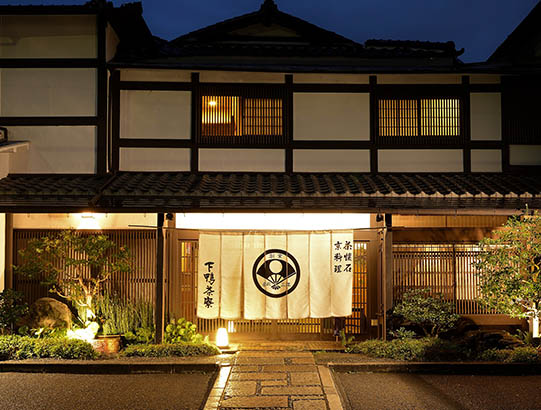
SHIMOGAMO SARYO HONTEN
A long-established Kyoto-style chakaiseki restaurant that has been in business for over 160 years. We hope you will fully enjoy a time when traditional yet constantly evolving and creative cuisine, service, and space all come together in perfect harmony in the name of Kyoto.
DEMACHI FUTABA
Demachi Futaba is a long-established shop that has been operating since 1899. Its signature product, the "mamemochi (red bean paste stuffed into mochi rice)," is Habutae mochi, which has an elastic texture with melt-in-your-mouth softness, filled with soft bean paste. It continues to be loved by a lot of people, with many of them getting hooked on this sweet.
KAMO MITARASHI CHAYA
This is the birthplace of Mitarashi Dango, which is said to have been created after the shape of the water bubbles that gush out of Mitarashi Pond at the Tadasu no Mori forest in Shimogamo Shrine. This shop is close to Shimogamo Shrine, which is also a World Heritage Site, and its dango is popular as a sweet sold in front of the shrine gate.

ARASHIYAMA / SAGANO AREA

TOGETSUKYO BRIDGE
The Oigawa river flows while reflecting Arashiyama, a famous spot for viewing cherry blossoms and autumn leaves, on the surface of the water. Built over Oigawa river, Togetsukyo bridge is said to have been named by Emperor Kameyama because it looked like the moon was crossing the bridge. You can also enjoy boating, sightseeing on a roofed pleasure boat, and cormorant fishing in the summer in the vicinity.

TENRYUJI TEMPLE
Tenryuji temple is a Zen temple representing Arashiyama in Kyoto. There are many attractions in the temple precincts, including Unryuzu, a painting of a giant dragon on the ceiling of Hatto temple, Darumazu that welcomes visitors, and a massive garden with Kameyama and Arashiyama as background.

OTHERS

KIFUNE SHRINE
Kifune Shrine, situated in Kibune which is the inner parlor of Kyoto, is an old shrine surrounded by fresh greenery. It is visited by many worshipers in search of beautiful scenery in all four seasons. In the summer, it is cooler in Kibune than in the city, so it has become a famous summer resort area. The view of Kibune River lined with raised platforms has become a special feature of summer in Kyoto.

SANZEN-IN TEMPLE
Sanzen-in temple is a Tendai Sect temple that is located in Ohara, Kyoto. It is home to the Shuheki-en Garden with a chisen kanshoshiki design (ornamental pond style garden) and the Yusei-en Garden with a chisen kaiyushiki design (a garden with a path around a central pond), both of which are Kyoto-designated places of scenic beauty. You can enjoy beautiful scenery here in all four seasons, such as mountain cherry blossoms and rhododendrons in spring, hydrangeas in early summer, autumn leaves in autumn, and a blanket of snow in winter.

RURIKOIN TEMPLE
Known as a famous spot for autumn leaves, it is visited by a lot of people when it is open to the public in spring and autumn. It is home to a Sukiya-zukuri style building standing on an approximately 39,669 sq.m., and a garden set against the backdrop of the majestic nature of northern Kyoto. The sight of the autumn leaves coloring Ruri no Niwa, a garden where moss glitters against the lazuli blue water, is truly exceptional.

RYOANJI TEMPLE
Ryoanji temple is home to a famous rock garden, which is officially known as Hojo Garden. This stone garden's aspect ratio is the golden ratio that is considered as the most beautiful ratio. It is enclosed by a fence made from clay mixed with oil. This fence makes Ryoanji temple's stone garden stand out like the frame of a painting as it creates a sense of depth by giving a slope to the garden to make the Hojo side seem higher.

KINKAKUJI TEMPLE
This famous temple is known as a symbol of Kitayama culture in Japan and overseas. The official name of Kinkakuji temple is Rokuonji. It is generally called Kinkakuji after the famous relics hall called "Kinkaku."

KITANO TENMANGU SHRINE
Kitano Tenmangu shrine is a shrine in Kyoto that is famous for its plum trees and autumn leaves. It enshrines Sugawara no Michizane, so it is more commonly called "Tenjin-san."

AROUND THE HOTEL
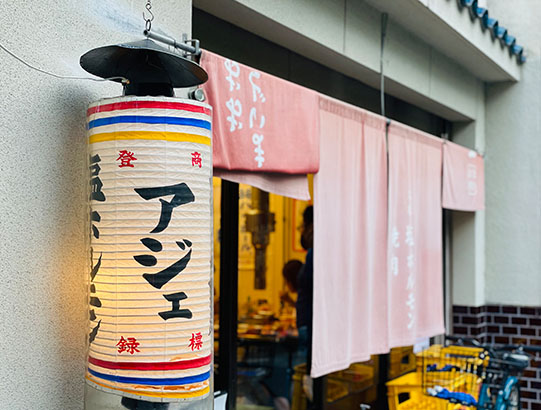
AJE KIYAMACHI DONGURI BRANCH
Mainly found in the Kansai region, this is a restaurant chain that serves grilled meats and offal. Premium offal dishes, such as small intestines in salt, come from the best breed of cattle that is handpicked through the cattle deposit system that is rare even in Japan. It is so popular that everyone in Kyoto knows about it and it gets extremely crowded every day and every night.
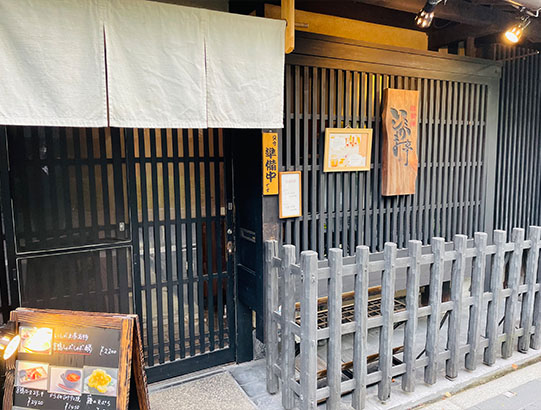
AJIROMAN ISHIGAMATEI
Ajiroman Ishigamatei is a restaurant located along the Kamogawa river in Kiyamachi, Kyoto. It has been specializing in Kyoto duck cuisine since it was established, offering such exquisite dishes as Kyoto duck shabu-shabu hot pot. Enjoy the tastes of Ishigamatei, which is particular about the use of seasonal Kyoto vegetables and ingredients such as bamboo shoots in spring and Kamo eggplant in summer.
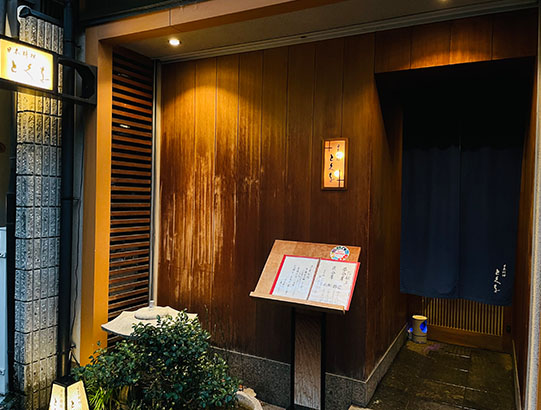
TOKUWO
Located in Shimokiyamachi, where the elegant atmosphere of Kyoto remains, Tokuwo serves seasonal ingredients chosen by the shop owner himself when he visits the market every morning. Feel free to enjoy authentic Japanese cuisine that takes advantage of the natural delicious flavors of the ingredients. Chat with the chef by sitting on the counter seats, or spend a relaxing time with your family and friends in a private room.
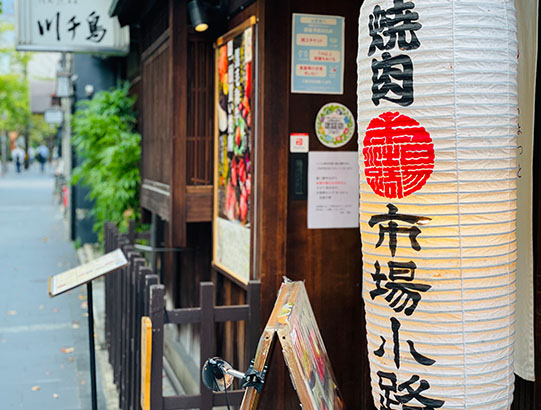
ICHIBAKOJI KIYAMACHI BRANCH
On May 1, 2019, the day of ascension to the throne by the emperor, a kyo-machiya (traditional townhouse in Kyoto) with a courtyard was boldly renovated. From the window of this restaurant, you will feel the changing of the season with such views as that of cherry blossoms in full bloom. Enjoy A4-grade meat from a long-established meat shop cooked the Japanese way and pair it with wine from the special underground wine cave.
ACCESS
Please see the access page below to learn about access to AOI Suites at Nanzenji and AOI Hotel Kyoto. Information about parking lot is also provided on that page, so if you are coming by car, please check that page before you visit.
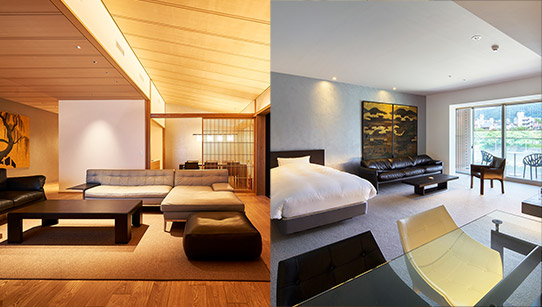
- TOP
- SIGHTSEEING


